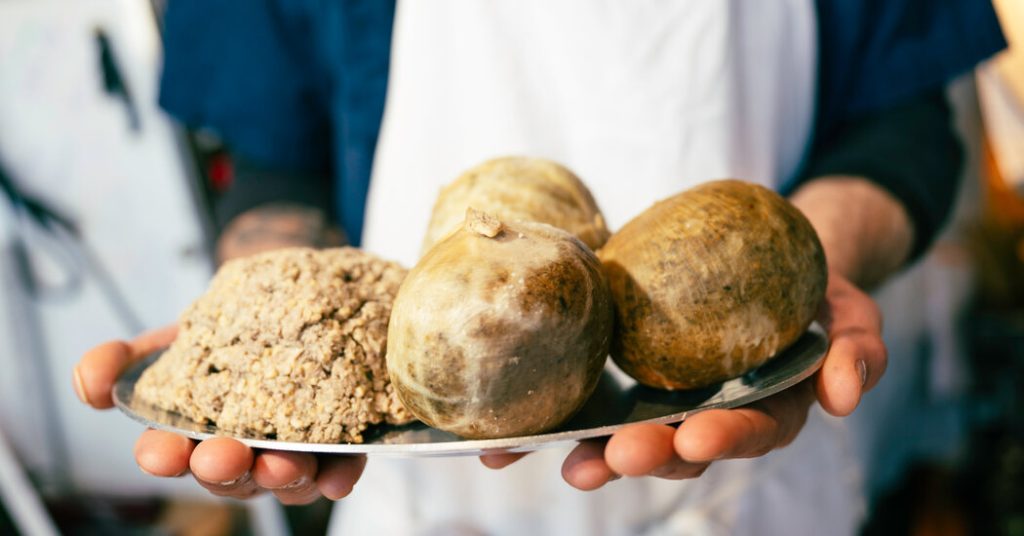The upcoming Burns Night celebrations for Scottish Americans and expats will mark a significant shift in the traditional consumption of haggis. For years, aficionados in the United States have lamented the absence of “authentic” haggis, due to a U.S. ban on importing haggis containing sheep lung, a key ingredient in the traditional recipe. This restriction has forced some to resort to the black market to obtain the real deal, a testament to their dedication to the culinary heritage of Scotland. However, Macsween, a prominent Scottish haggis producer, has developed a novel recipe that circumvents this import restriction by substituting lamb heart for sheep lung. This adjustment allows the company to finally introduce a genuinely Scottish, albeit modified, haggis to the American market.
This isn’t the first time Macsween has adapted its recipe. Recognizing evolving culinary preferences, the company previously replaced the traditional sheep stomach casing with a beef casing, similar to those used for sausages. While some purists may argue that the lung contributes a unique texture, the general consensus is that the average consumer is unlikely to notice the difference. This adaptation for the American market is a significant step for Macsween, which sells approximately eight million pounds of haggis annually in Britain, where the traditional recipe with sheep lung remains the standard. The company sees vast potential in the U.S. market, envisioning haggis becoming a regular culinary item beyond the confines of Burns Night celebrations.
The journey to bring Scottish haggis to the United States has been a long and arduous one. The ban on haggis containing sheep lung originated in the 1970s, effectively barring the importation of traditional haggis. This was compounded in 1989 by a ban on British lamb and beef imports following the mad cow disease outbreak. James Macsween, the managing director of Macsween, has been actively working to reintroduce Scottish lamb and beef to the North American market since 2015. The easing of restrictions on lamb and beef imports in 2022 paved the way for Macsween’s entry into the U.S., but the lung ban necessitated the lamb heart substitution.
While American-made haggis exists, it doesn’t replicate the true Scottish experience. Macsween’s new recipe, already successful in Canada, aims to provide the most authentic Scottish haggis possible within U.S. regulations. The recipe utilizes lamb heart and fat, oatmeal, a blend of peppers, aromatic herbs, salt, onion, and broth, mirroring the traditional recipe as closely as legally permissible. This commitment to authenticity aims to satisfy the demand for genuine Scottish haggis while adhering to U.S. import regulations.
However, the reception to Macsween’s modified haggis in the U.S. remains to be seen. Some remain skeptical, questioning whether the altered recipe will truly capture the essence of traditional haggis. Anne Robinson, the founder of Scottish Gourmet USA, a prominent purveyor of domestically produced haggis, acknowledges the specialized nature of the haggis market and welcomes Macsween’s entry, while also expressing some reservations about navigating U.S. regulations. This highlights the existing market for haggis in the U.S., albeit one currently served by domestically produced versions, often using ground lamb and beef liver, venison, or even vegetarian substitutes.
Despite the challenges and skepticism, there’s optimism surrounding the introduction of Macsween’s haggis to the U.S. market. Greg Brockman, a butcher in Brooklyn with firsthand experience of Macsween haggis from his time in Scotland, offers a positive perspective. He acknowledges the initial apprehension some Americans may have towards haggis, often perceived as an unusual food. However, he emphasizes the appealing blend of warm spices and the subtle iron tang from the heart and liver, ultimately creating a flavorful and aromatic dish that transcends its unassuming appearance. This sentiment echoes Macsween’s belief in the versatility of haggis, envisioning its potential beyond traditional consumption, incorporating it into dishes like haggis pizza, lasagna, and poutine, thereby broadening its appeal to a wider audience. The arrival of Macsween’s haggis promises a renewed and potentially transformative experience for haggis enthusiasts and curious newcomers alike in the American culinary landscape.












